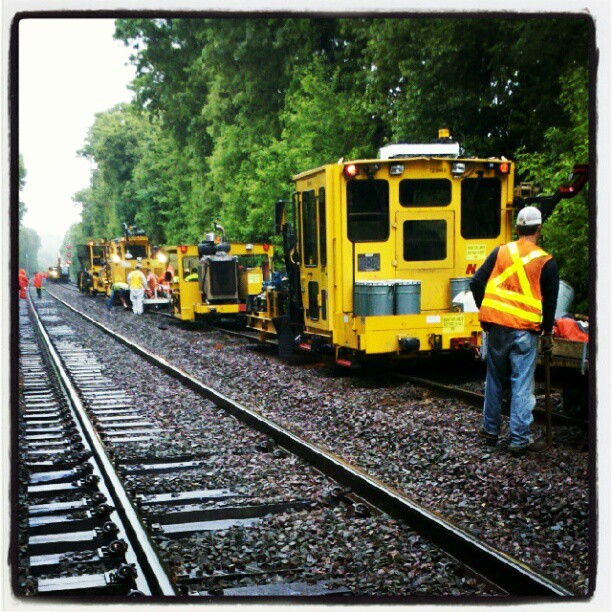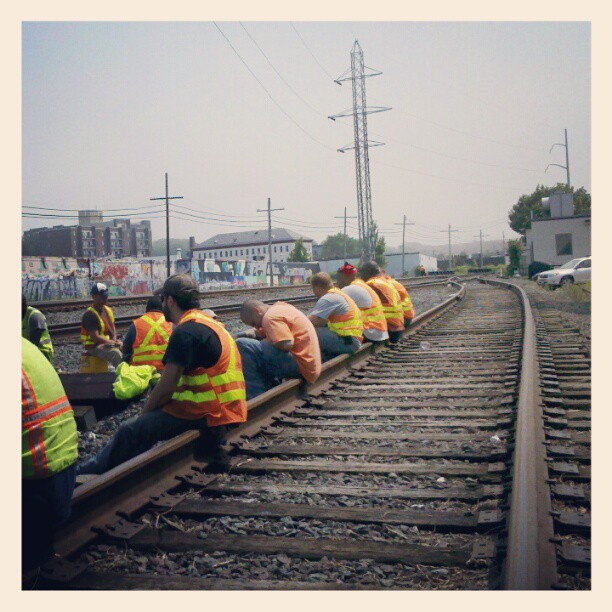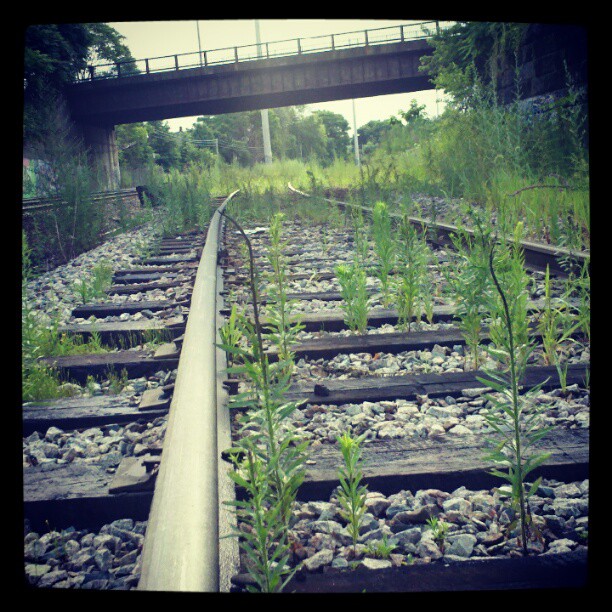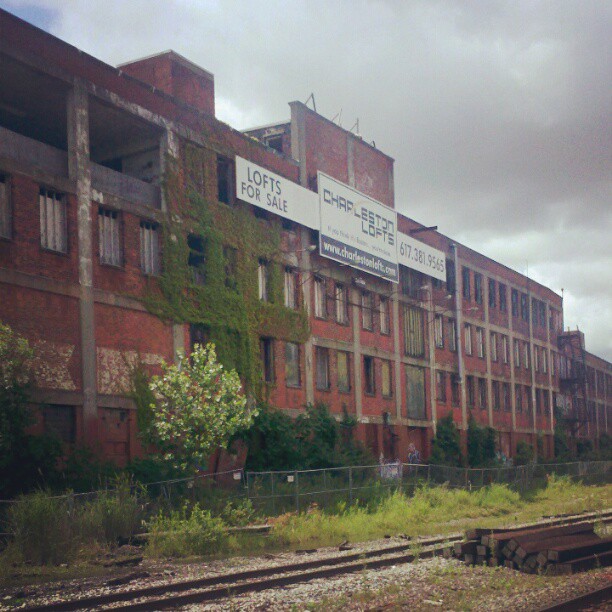The job rolls north through Chelsea. This section of track bisects some scrap yards and the ruins of old factories from fields of gas tanks and piles of crushed stone. We march behind the tamper, inhaling its exhaust, suffering the drone of the engine despite the foam plugs stuffed in our ears. The hydraulic sleepers on either side plunge vibrating tines into the ballast under each newly installed tie and squeeze, packing the stone, lifting the new tie toward the rail. When the tamper finishes, the four of us fork stone from the space between the new tie and the one in front of it so we can set the plates there. The two-man team operating the railjack moves in when we’ve gone, jack the rails, then they bend down and slide the plate onto the tie before disengaging the jack and rolling forward. On a productive day, this cycle will repeat itself about six hundred times. The deafening activation of hydraulic components. Bending at back and knee to clear stone. Muscling plates between wood saturated with creosote and steel radiating heat absorbed from the summer sun. Ours is a glamorous existence. But, as a friend reminds me, I’m not the guy who has to shovel shit at the chicken house. So there’s that.
We come to a stop beneath a bridge. Up ahead a machine has broken down. The shade under there is a small relief, but we take it. James steps the off the track and stands with me in the low weeds. His face is streaked with dirt and his shirt is dark with sweat. He’s smiling, shaking his head.
“See that?” He nods at the far track, the number one, usually the inbound, today pulling double duty as we change out the old ties on the number two.
“See what?” I say.
“The cat,” James says.
A small group has gathered. Richie, who operates the tamper, walks past me clucking his tongue. Richie is missing his upper row of teeth and believes in alien visitation to Earth, and he seems genuinely upset.
“What’s up, Richie?” I say.
“Poor kitty, Johnny,” he says.
I shoulder through the crowd for a look.
The body of a cat is lying on either side of the rail, cut in two. The head and the forelegs rest in the gauge between the tracks, the other half lies on the field side, in the stone. The eyes and mouth are closed, the ears are perked, the tail is limp. The lack of blood is confusing at first, until I calculate some numberless arithmetic: the speed of the train plus the friction of its wheels against the rail and no shit, the cat’s flesh was cauterized.
We see dead stuff all the time. Usually it’s not this fresh, just piles of bones or decomposing scraps of viscera and fur. Someone takes a picture with their phone and I consider doing the same. I’ve been doing that recently, clicking shots of scenes strange and pleasing, creating a record, I guess. I don’t this time. I chicken out. But it’s OK. This isn’t something I’ll forget.
Now we’re in Lynn, or Revere, maybe Saugus. One day spills into the next; it’s hard to tell them apart. On both sides of the tracks there’s marshland and standing water, thick stands of trees and low-growing brush. I grew up in a city. I can’t name the trees and bushes to save my life. We could be anywhere.
Works starts the same every day: we hit clips with sledgehammers. The clips hold the ties to the rail and they need to be knocked off the plates before the machines can pull out the old ties and other machines can put in the new ones. So we—the track dogs, the guys lacking in seniority and not qualified to run machines yet—get good and sweaty every morning. It’s monotonous work. The hands swell from the constant contact. The mind and vision drift.
Today, it’s my turn to spot a corpse. It’s under a bush thick with yellow and red berries. Behind the bush is a pond, the surface crowded with lily pads from which bright yellow flowers bloom. Tall, white egrets step carefully between the pads, trying to spear some frogs, I think.
“Check it out.” I bump Marlon with the handle of my sledge. We have worked far ahead of the others, so he’s the only one close enough to share this with. He’s a Jamaican kid around my age with a neatly trimmed beard running along his jaw and arms as thick as his accent. He wears a towel draped over shaved head going bald, held in place by a red headband. From the neck up he looks ready for a trek across the desert, but he’s told me he learned the trick working with his grandfather back on the island when he was a kid, chasing escaped pigs and goats, mending rotten fences. “The bird,” I say.
We both squat down for a closer look.
“That a baby eagle?” he asks.
“It’s a hawk.”
The body is intact. If the hawk was hit by a train then it was a near miss, a couple flaps shy of escape. This is the closest I’ve been to this kind of bird, living or dead. The feathers shimmer and the talons are the yellow of the painted lines that divide a busy street. It looks small, but is it? Maybe this is a young hawk, or a female, but are female hawks bigger than male hawks? One of the guys from New Hampshire might know but none are close enough to ask. With no answers, I leave the dead bird under the bush and join Marlon hitting clips off the plates again. The rest of the guys are catching up. There’s a ways to go.
From one morning of swinging sledgehammers and tossing loose clips into the space between the tracks, to another. I knock off my share of clips and catch up to the main group. They’ve lowered their hammers and huddled around something. Another dead cat, I think, and laugh a little. But this time it’s a praying mantis, one as long as my hand, trying to climb over the rail. An injured hind leg prevents the mantis from getting over. I watch it scurry and flail. The other watch too, and they’re quiet.
“Somebody just kill it,” I say.
“Hold up, Johnny. I got him.”
Neil breaks steps forward. He’s kind of a mantis-shaped guy, tall with long arms and legs. He adjusts the scally cap pulled low on his forehead to shadow the hangover rimming his eyes, squats over the rail, cups his hands around the mantis and carries it away from the tracks. He places it next to a tree. It’s a kind gesture, if useless. The injured mantis will become fast-food for any predator that happens to pass by.
The watchman standing a few football fields north of where we gathered blows the air-horn and lifts the sign with the reflective “W” on it high over his head. The other two watchmen, one even with us and the third a ways off to our south, do the same. We don’t do any work on the tracks without the watchmen. With the horn and the sign they warn us that a train will be entering our position and we need to drop our tools and get clear. Unless we want to end up smashed apart, or cut in half.
All of us jump off the tracks and gather near the tree line. We wait and faster than you expect, the train comes around the curve. It’s moving fast, maybe 60 miles per hour, and the details of the passengers’ faces in the small, rectangular windows are lost. They become a blur, smears of color in motion. If any of them put down their newspapers or tablets and peer out from that world and into this one, at us, it’s impossible for me to know. At first I imagine we must appear as flashes of color too, but that’s not how it works. We’re stationary, and up there perception is different. They might see a mix of orange T-shirts and blue jeans; forearms and faces burned dark by the sun. We’re more visible than the bones and flesh gone to rot, but not much more. The line between us is thin.
The passengers probably never see the men standing near the tracks. I doubt they look, and that’s fine. They are rushed off to jobs behind desks in office towers where the air temperature is managed and the light of the sun is deflected by the tinted glass of the windows. We’re left to go about our business, down here, breathing the heat and diesel fumes, where we walk on wood and stone and taunt the dead things we find.







